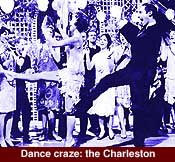|
January 1. The Charleston, the dance that scandalised
America, took Britain by storm. It began as a rebellion against
the staid, stuffy ballroom dancing of earlier years but developed
into a social phenomenon.
 The
old order was changing. Jazz and ragtime music was all the rage.
The traditional image of studious, stiflingly-respectable womanhood
was kicked out. Young women loved it because they could be themselves.
Men loved it because they could see the girls' legs in daringly
short skirts. The
old order was changing. Jazz and ragtime music was all the rage.
The traditional image of studious, stiflingly-respectable womanhood
was kicked out. Young women loved it because they could be themselves.
Men loved it because they could see the girls' legs in daringly
short skirts.
The writer George Bernard Shaw praised the new shorter hemlines
as being "for real human beings rather than upholstered Victorian
angels."
Catholic bishops in Italy were not so impressed. Women deemed
to be scantily dressed were banned from churches.
It was the age of the flapper, wild young things who wanted
to party. And as with every other fad, there were plenty of critics
eager to warn of catastrophe. Some specialists even predicted
that girls who danced the Charleston could damage their pelvises,
making them unable to bear children.
July 21. At the end of the famous "Monkey Trial" in Tennessee,
biology teacher John Scopes was fined $100 after being found guilty
of teaching Darwin's evolution theory to America's schoolchildren.
The judge in the trial moved the hearing to the gardens outside
the courthouse because so many people were trying to force themselves
into the building the courthouse was in danger of collapse..
The streets were filled with hundreds of religious fundamentalists
who cheered, sang hymns and prayed as the jury handed in its verdict
after Darwin's theory that humans were descended from monkeys
was ridiculed in court.
The famous attorney, Clarence Darrow, led the defence.
September 29. In a bid to cut accidents the Ministry
of Transport decided to paint white traffic lines on roads across
Britain. The plan was to split streams of traffic at intersections
or on dangerous bends .
And the famous London landmark. Piccadilly, was given the green
light as plans were drawn up for traffic lights to give an uninterrupted
flow past several crossroads at a time.
There were also worries that the 1925 Motor Show at Olympia
would result in a surge of new cars on the roads. With no motor
show in Paris that year, Olympia was viewed as the the focal point
of an international industry.
November 11. Howard Carter and his team of experts caused
great excitement at Luxor, Egypt, as three years of painstaking
work hit its climax when Tutankhamun's mummified body was unwound.
Their investigations showed that the boy king was about 15 when
he died and as the bandages were removed, 143 items of gold and
jewelled ornaments were revealed.
The toes and fingers of the teenage king were protected by golf
stalls - and his head lay under a gold mask which Carter believed
was a perfect portrait of the face just before death.
November 20. The widow of King Edward VII died at Sandringham.
Queen Alexandra was born one of two beautiful Danish princesses
- the other ended up as Empress of Russia. Alexandra was welcomed
to Britain with a poem by Tennyson.
Noted for her generosity, the Queen thought nothing of giving
away family heirlooms to friends. The King, her son , would send
Lord Esher, a man of impeccable tact, to get them back. Alexandra
also loved to live among vases of roses.

|